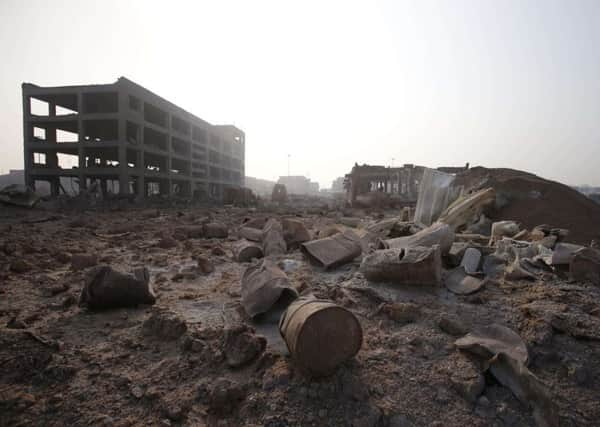China’s new toxic leak fear at blast site


More than 700 people were injured and 95 people, including dozens of firefighters, are missing after a fire and rapid succession of blasts late on Wednesday hit a warehouse for hazardous chemicals in a mostly industrial area of Tianjin, 75 miles east of Beijing.
By yesterday, authorities confirmed there were tons of the toxic chemical sodium cyanide on the site at the time of the blasts, although they said there have not been any substantial leaks.
Advertisement
Hide AdAdvertisement
Hide AdSodium cyanide is a toxic chemical that can form a flammable gas upon contact with water, and several hundred tons would be in clear violation of rules cited by state media that the warehouse could store no more than ten tons at a time.
Tianjin officials have ordered a citywide check on any potential safety risks and violation of fire rules, mandating suspension of operations for factories that cannot immediately comply with safety rules. Chinese Premier Li Keqiang was in Tianjin yesterday, visiting those injured and displaced by the disaster.
The country’s top prosecuting office announced yesterday that it was setting up a team to investigate possible offences such as dereliction of duty related to the massive blasts.
State media have reported that Zhi Feng, general manager of the warehouse operator Ruihai International Logistics, was already under police watch while getting medical treatment.
The death toll includes at least 21 firefighters – making the disaster the deadliest for Chinese firefighters in more than six decades – and the toll could go much higher. About 1,000 firefighters responded to the disaster, and 85 of them remained unaccounted for yesterday. Angry relatives of the missing firefighters and local residents whose homes were destroyed by the blasts showed up at a government news conference yesterday to demand information and accountability.
The public has raised concerns whether firefighters were put into harm’s way in the initial response to the fire and whether the hazardous materials were properly taken into account in the way firefighters responded.
The massive explosions late on Wednesday night happened about 40 minutes after reports of a fire at the warehouse and after an initial wave of firefighters arrived and, reportedly, doused some of the area with water.
Outside the Mayfair Hotel, where the authorities hold regular news conferences, a woman pleaded for information on her husband.
Advertisement
Hide AdAdvertisement
Hide Ad“They have said nothing. We know nothing,” the woman said. “We’ve been told nothing.”
Another man demanded information from a government official. “We’ve been here for three days, and we’ve not had one piece of information,” he said.
Local officials have been hard-pressed to explain why authorities permitted hazardous goods warehouses so close to residential complexes and critical infrastructure, clearly in violation of the Chinese rule that hazmat storage should be 1,000 metres away from homes and public structures.
Homeowners of the nearby Qihang residential compound yesterday unfurled banners demanding government accountability and proper compensations for their damaged homes. Many were wearing masks, and some had bandages, possibly over cuts.
Many people in the area suffered injuries from glass shattered in the huge fireballs that lit up the night sky on Wednesday night.
Shi Luze, chief of staff for the People’s Liberation Army’s Beijing region, said authorities believe there were “several hundred” tons of sodium cyanide at the warehouse. He said that leaked chemicals were being neutralised and those still in packages removed from the site.
About 3,000 soldiers had been dispatched to the disaster zone to clean up any leaks of hazardous materials.